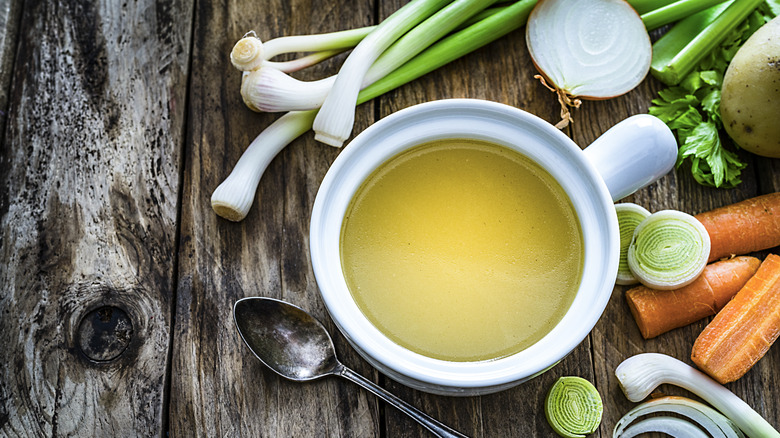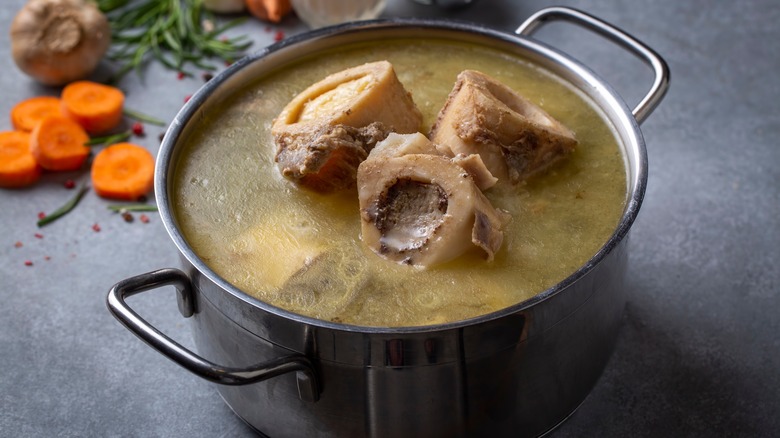Broth Vs Stock: What's The Difference?
Stock and broth might seem like two different names for the same flavorful liquid — the same way bell peppers are also known as capsicums, rocket as arugula, and eggplants as aubergines elsewhere. After all, both are made by simmering vegetables (often mirepoix, which is a combination of onions, celery, and carrots), herbs, aromatics, and meat in water. They are then used as building blocks for wonderfully complex soups, stews, sauces, and more. But don't mistake them for two interchangeable things — stock and broth are not the same.
The most important difference between the two is the use of bones: Broths (not to be confused with consommé) primarily use animal flesh whereas stocks are made from bones. This, in turn, affects cooking time as well as color and consistency. Stocks are generally cooked for about four to six hours. The long simmer allows the water to fully extract the collagen and gelatin that is present in animal bones, giving stocks a thicker and fuller consistency — so much so that they almost settle into a jelly-like consistency in the fridge. Sometimes, the bones are also often roasted before simmering, which means some stocks have a deeper color as well.
On the flip side, broths can come together in as little as 45 minutes and are thinner in comparison. Another important factor that distinguishes the two is salt: Broths are often pre-seasoned and contain salt whereas stocks usually lack seasoning.
When to use stock versus broth
Broths and stocks can be used interchangeably in most recipes such as comforting soups and gravies, or when you're using them as cooking liquids to pack flavor in grains like rice. In general, however, it's good to remember that stocks have a more neutral flavor than broths. This is why they are used as building blocks for dishes to construct more complex flavors. On the other hand, broths are often the backbone of a dish and are thought of more as an element rather than a base.
That said, there are times when you will want to be more cautious with using the two liquids interchangeably. Stocks have a deep color and thick mouthfeel, so if your dish depends on their richness, swapping them with broths will leave much to be desired. Take those velvety brown sauces to go on top of meats, for example.
Additionally, salt is another factor to consider. For instance, you might want to reduce the amount of sodium that you add when you're using broth in place of a stock. Taste the dish as you go, and if things start to get too salty, consider splashing in some water to dilute the salinity. On the flip side, you'll want to add more salt on top when you use stock in place of broth to make up for lost sodium.
There are certain exceptions
There are different types of stocks and broths — some feature meat and poultry while others contain fish. The use of flesh versus bones is the main distinguishing factor, but there are certain exceptions. For one, vegetable stocks and broths don't contain any animal products. The main difference here is that a vegetable stock is made from whole, untrimmed vegetables. However, the broth version features chopped vegetable trimmings, and you can often swap water with vegetable broth. Much like their meaty counterparts, vegetable stock is cooked for longer than a broth and does not contain any salt.
Then there is the befuddling matter of bone broth, which technically classifies as a stock but is labeled otherwise. Coveted for its purported nutrition, this liquid is a hybrid between the two. It is made by simmering roasted animal bones for over 24 hours and more closely resembles a stock in that sense. However, it is also seasoned like a broth, sometimes has meat, and is flavorful enough to be drunk plain.
Store-bought stocks and broths are also an exception as they may use the two terms interchangeably. You might find stocks that are packed with sodium and even broths that feature bones. When in doubt, always taste the liquid before you start cooking — this will give you a better idea of its flavor, texture, and consistency, and what you can then do with it.



